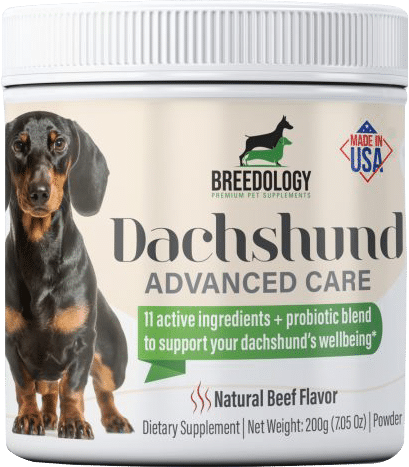Dachshunds are adorable and well-loved dogs that make perfect companions for the family. In case you’re unsure if a dachshund puppy is purebred, there are several ways you can check. The purebred dachshunds come from selective breeding and should have all the necessary documentation.
Owning a purebred dachshund puppy means the pup is predictable in its development and will have all the necessary traits and behaviors typical of the dachshund breed.
It is a well-known fact that purebred puppies command a higher price, not only for a reason mentioned above but also because the breeder carries many expenses.
They include puppies vaccination, medical expenses, food supplies, and the cost of the registration documents.
There are a few main methods that can help you define if your dachshund is purebred. They include visual assessment, your dog pedigree, and the DNA testing.
In this article, we will highlight all three of these methods, discussing their accuracy and efficiency.
Is Your Dachshund Purebred? Visual Assessment

The first and easiest step in defining if your dachshund is purebred is, indeed, visual assessment.
It is essential to mention that, although it is the easiest way, it is also the least accurate one. Visual inspection implies comparing your dachshund’s physical characteristics to a kennel club’s official breed standard.
It is a well-known fact that the breed standards slightly differ from one kennel club to another. According to the American Kennel Club breed standard, the physical characteristics of a dachshund are the following:
- Height is 8 to 9 inches for a standard dachshund and 5 to 6 inches for a miniature.
- Weight is 16 to 32 pounds for a standard, and 11 pounds and under for a miniature.
- The body is elongated in shape and low to the ground, short legs, robust muscular development, the skin with no excessive wrinkling.
- The head tapers uniformly to the tip of the nose.
- Medium-sized, dark-rimmed, almond-shaped eyes.
- Alert facial expression.
- The ears are set near the top of the head, not too far forward, of moderate length, not pointed or folded.
- Long, muscular, clean-cut neck
- Long and muscly trunk. The abdomen is slightly drawn up.
For the full standard of the dachshund breed, please visit the American kennel club website.
Accuracy of Visual Assessment
As mentioned earlier, visual assessment is the least accurate method of defining if your dachshund is purebred. There is a lot of controversy around this technique.
In some cases, a Dachshund can look like a pedigree, but be a cross-breed. And on the contrary, a Dachshund that has no resemblance to the breed standard can be purebred according to its Pedigree.
Overall, visual assessment can be a good starting point. Yet, to understand better your dog’s genetics, it always helps to study your dachshund’s papers as well.
Is Your Dachshund Purebred? Pedigree and Registration Documents

As mentioned earlier, the breeding of purebred dachshunds is backed with the necessary documentation, known as Registration Documents and a puppy’s Pedigree.
When you buy a puppy from a reputable breeder, he should provide you with the registration document with both parents’ information.
As well as that, the breeder will give you a copy of a pedigree, practically an ancestry tree back from a few generations. A serious breeder will be proud to show you the Pedigree and explain it to you.
Please beware of the breeders who don’t seem to know about the Pedigree of their dogs.
As we mentioned earlier, a Pedigree is simply a family tree of your future puppy. Typically the Pedigree will consist of 4 to 5 generations.
It will show the full information about the puppies’ parents, including their full names, titles, and special honours.
The fact that your breeder will have a pedigree in addition to the registration document proves that he is a reputable and responsible breeder.
Don’t forget that appearance, temperament, intelligence, and health are factors determined by a puppy’s genetic make-up.
It is important to remember that the breeder must provide you with at least one of these documents. It is the minimum requirement of buying a puppy from any breeder.
If you have the Pedigree papers from a reputable breeder, then you can be almost sure that your dachshund is purebred. However, bear in mind that the registration system has its flows. There is always a way for unscrupulous breeders to register the litter using the incorrect data.
The best way to help your dachshund live longer?
Watch our video to find out!
Is Your Dachshund Purebred? DNA Identification
DNA testing will allow you to understand your dachshund genetics better. The tests are helpful not only for determining your dachshund’s Pedigree but also for identifying any genetic conditions that might affect your dog later in life.
Nowadays, it is possible to perform the DNA test for most breeds.
The testing requires you to take a simple swab from your dog’s mouth.
Sometimes a blood sample is needed, but these cases are rare.
You can order a DNA test at The Laboratory, or simply buy a test kit at Amazon.
Ordering the test online could be a much more comfortable and quicker option, and it includes three easy steps:
- Collecting your dachshunds DNA with a chick swab
- Registering your kit sample online
- Sending your kit sample over to the lab
Accuracy of Home Test Kits
The DNA test companies’ representatives claim that the results are 95 to 99% accurate, considering human error and the breeds’ database size.
Rarely, false matches can happen, and a second test would be required. The risk of false matches is higher in smaller labs with fewer DNA records in a database.
Most results are ready around 2-3 weeks after the lab receives your dog’s DNA sample.
The company Wisdom Panel provides one of the most accurate canine DNA tests. You can choose a test according to genetic information you want to know – either canine breed detection or expended disease detection.
Wisdom Panel Essential – Dog DNA Test for Ancestry, Traits, and Medical Complications. Tests for 350+ breeds, types, and varieties, 25+ genetic conditions, 35+ traits, and more.
Wisdom Panel Premium – Dog DNA Test for Comprehensive Health, Traits, and Ancestry. The most comprehensive dog DNA test available. Screens for 200+ genetic conditions, 350+ breeds, types, and varieties, 35+ traits, and more.






Comments
My dachshund has longer legs than other dachshunds, is he pure and can he be pure? I want to know. He stands 9.5 inches tall and he weighs 13 pounds, what size is he?